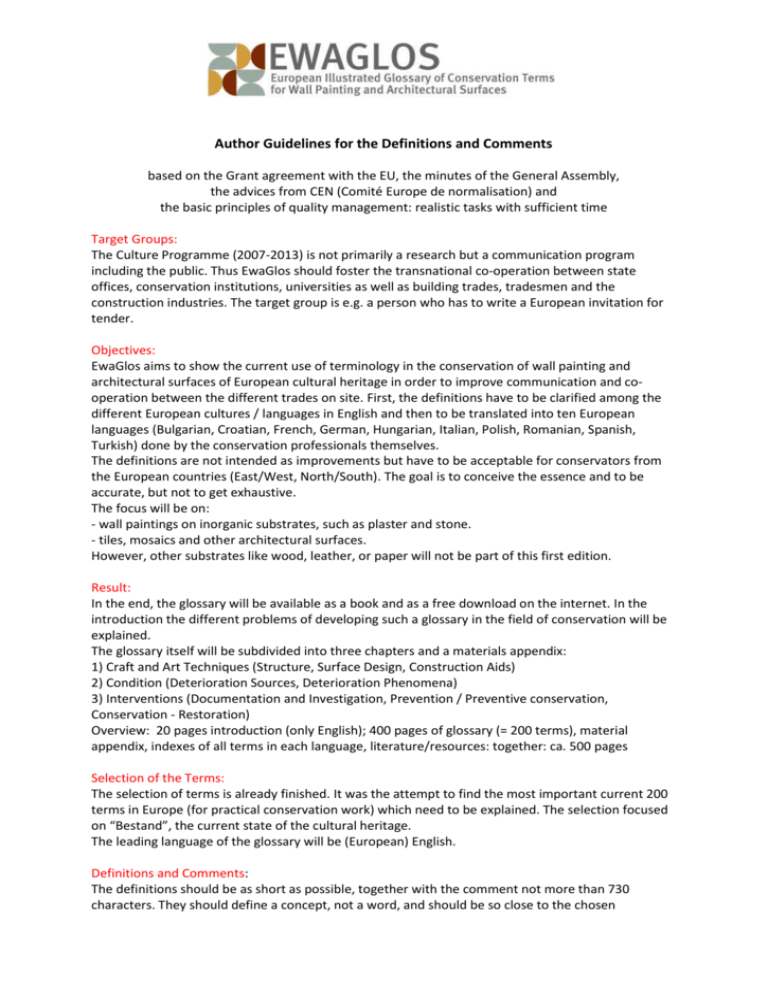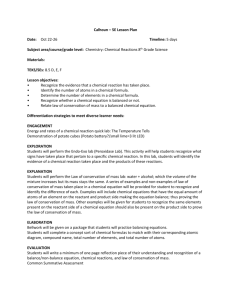Guidelines for the Review of Definitions and Comments
advertisement

Author Guidelines for the Definitions and Comments based on the Grant agreement with the EU, the minutes of the General Assembly, the advices from CEN (Comité Europe de normalisation) and the basic principles of quality management: realistic tasks with sufficient time Target Groups: The Culture Programme (2007-2013) is not primarily a research but a communication program including the public. Thus EwaGlos should foster the transnational co-operation between state offices, conservation institutions, universities as well as building trades, tradesmen and the construction industries. The target group is e.g. a person who has to write a European invitation for tender. Objectives: EwaGlos aims to show the current use of terminology in the conservation of wall painting and architectural surfaces of European cultural heritage in order to improve communication and cooperation between the different trades on site. First, the definitions have to be clarified among the different European cultures / languages in English and then to be translated into ten European languages (Bulgarian, Croatian, French, German, Hungarian, Italian, Polish, Romanian, Spanish, Turkish) done by the conservation professionals themselves. The definitions are not intended as improvements but have to be acceptable for conservators from the European countries (East/West, North/South). The goal is to conceive the essence and to be accurate, but not to get exhaustive. The focus will be on: - wall paintings on inorganic substrates, such as plaster and stone. - tiles, mosaics and other architectural surfaces. However, other substrates like wood, leather, or paper will not be part of this first edition. Result: In the end, the glossary will be available as a book and as a free download on the internet. In the introduction the different problems of developing such a glossary in the field of conservation will be explained. The glossary itself will be subdivided into three chapters and a materials appendix: 1) Craft and Art Techniques (Structure, Surface Design, Construction Aids) 2) Condition (Deterioration Sources, Deterioration Phenomena) 3) Interventions (Documentation and Investigation, Prevention / Preventive conservation, Conservation - Restoration) Overview: 20 pages introduction (only English); 400 pages of glossary (= 200 terms), material appendix, indexes of all terms in each language, literature/resources: together: ca. 500 pages Selection of the Terms: The selection of terms is already finished. It was the attempt to find the most important current 200 terms in Europe (for practical conservation work) which need to be explained. The selection focused on “Bestand”, the current state of the cultural heritage. The leading language of the glossary will be (European) English. Definitions and Comments: The definitions should be as short as possible, together with the comment not more than 730 characters. They should define a concept, not a word, and should be so close to the chosen illustration that the illustration is clear without further explanations. Try to define the main criterion and try to also work out what distinguishes the term from other terms. Try to have a hierarchy in a definition, starting with the broad definition like "painting technique", and continue with the more specific details like the binding medium of this painting technique. Mentioned sub-definitions without its own double-page should be included in the index and should be marked - in English and in the translations. Try to avoid "etc., "like", and other uncomplete listings. If necessary at all, put it in the comment. The content should stick to the conservation/restoration of wall painting and architectural surfaces and not drift into other fields of conservation or even further off. For systematic correctness, try to use for your definitions already existing terms from our glossary and refer to other terms of the glossary (cross references). In case of problems or different opinions about a definition it could be helpful to give these terms several definitions and explain it in a commentary. Content of the Definition and of the Comment: Definition - explains the function of the material (i.e. consolidation), the technique, or the aim of a process (i.e. protection of the work of art, or aesthetic improvement) - mentions the generic materials used (what is it composed of, what does it comprise)? - tries to explain the concept of the term. (Define a concept = A wood hammer is a tool made of wood with a cylindrical head used to beat or knock. Do not define a word = A wood hammer is a hammer for hammering wood). - starts with the broad definition and continue with the more specific details (like the binding medium of this painting technique) - does not drift into other fields of conservation - If the term has several definitions, it is explained in the comment Comment: - Technical details and characteristics; - Examples for the use and for specific materials; - Regional characteristics of a material, or the use and perception or appreciation of a technique, approach or process, if it is important for a bigger part of Europe; - Historical aspects of the concept, technique, approach, process or the material (not of the term); - Critical comment (e.g. dangers or limitations, typical problems of a conservation treatment); - Synonym terms, different meanings, adopted from another language, relation to other terms, similar terms? Sources: Due to the fact that this is a European project with 11 languages the mentioned sources (short titles with page!) should give an overview about the leading up to date European literature and Epublications, most suitable with additional information. Please, do not list general bibliographic references, but only a publication, which you used to define and comment the term. If possible there should appear the title of a specialized textbook or professional article and not only other glossaries and encyclopaedias. Cross references: Please, check that you only refer to words and terms, which are content of the glossary. Do not list various keywords instead. EwaGlos can not: - show differences in historic and current usage, e.g. the differences of use between the Mora, Mora & Philippot 1984 in English and the 2002 Italian version or that of the Florentine Botticelli 2010; - show differences between Italian terminology in Italy and their use in other countries; - show regional/school differences in the countries; - show differences between wall painting usage and standard terminology in other specialism’s; - show similarities and/or differences between the use in English speaking countries and elsewhere; - explain historical contexts and origins of the terms; - educate the proper way of conserving/restoring cultural heritage. Current terminology: EwaGlos aims to show the current usage of the terminology. It will be a communication tool for specialists who are involved in conservation projects of wall paintings/ architectural surfaces and need to communicate in international teams. Please, take into consideration that terms in report writing and publications can be different to their current use on site. Academics may use different terminology to the conservators communicating on the scaffold! You can find out whether a term is used nowadays by sending a request to the national Corpus organization or to ask restorers being active in the job during the projected National Workshop. At least, the pre-publication of the glossary on the internet in April 2015 could help with everybody´s critical comment. The use of Italian terminology in today’s practical work has to be decided from case by case and in every language. A compromise could be to put the Italian terms in the index of every language so that users will find them. Outlook: a second edition Up to now I would be happy if we could motivate colleagues from more European countries to add their own translations so that after some years the partners will be able to publish an advanced second printed edition. HAWK, Hildesheim, 25th of August Angela Weyer







